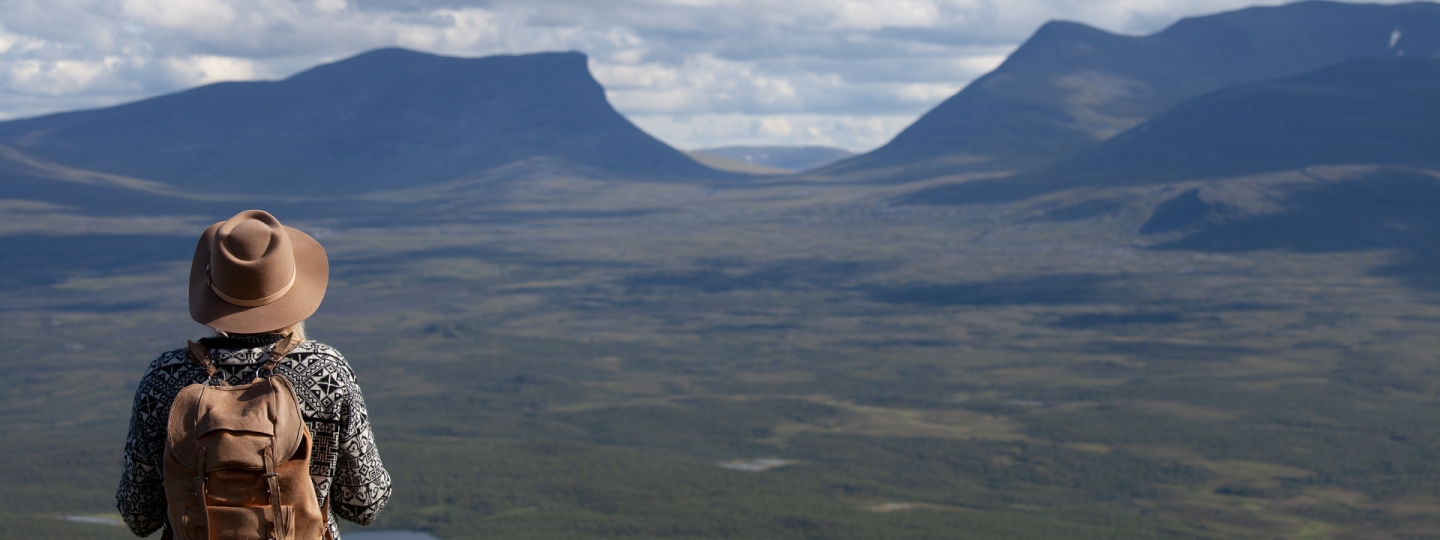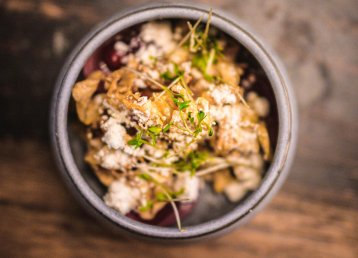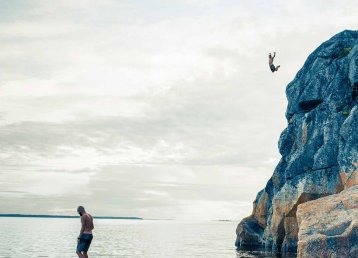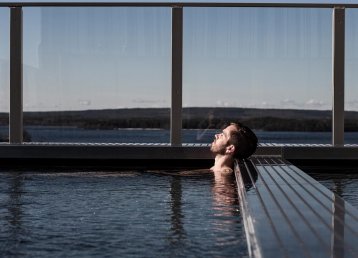Memories and hearsay
Somewhere beyond Bastuträsk the train rolls resolutely into the destination known as Swedish Lapland. In Lillvattnet, alias Jörn, famous Swedish writer Sara Lidman’s Jernbaneepos begins. This is an area often acknowledged for its storytelling. It is said that Lenin, on his way home to the revolution, also stopped here and had a bath at Järnvägshotellet in Jörn, but that may be just hearsay. In some way it is rather surprising that, when the tale is told, so many are pleased that Lenin is the main character. On your journey northward, travelling on Tågsemesterkortet (the Train Holiday Card), you’ll hear about Lenin here in Jörn, see his image on a mural in Boden and then on a copper relief in Haparanda. That the Indian mystic and Nobel Literature Prize winner Rabindranath Tagore once stayed at the hotel in Jörn is a little-known fact. And now the memory of Tagore is as sleepy as the railway hotel itself.
The train arrives in Älvsbyn and you decide to hop off, so you can behold the spectacular Storforsen, Europe’s largest untamed rapids or waterfall, and a nature reserve that is well worth a visit. Later in the evening, you’ll be able to run up Hundberget for a fantastic view of one of Sweden’s National Heritage Rivers, the Pite River. You sit there on the high cliff overlooking the river valley with all its beauty. The cliff laid bare is a reminiscence of the ice age. The warm hard rock makes it easy to understand the saying that “a serpent on the rock” is a mystery.
Also read
Swedish Lapland's guide to ÄlvsbynNorrland’s Riviera
A day later you continue onward towards Luleå and the coast, travelling with ease and arriving ideally in perfect time for lunch. You make a stopover in town where you choose between the open-air café at Hotell Savoy or the sushi restaurant Odod Art opposite. The latter becoming the winner, but as desert you get an affogato at Savoy.
University town Luleå is bathing in sunlight. And that’s not unusual. Luleå is often victorious when it comes to most hours of sunlight in Sweden. Back in the 1950s, Swedes were surprised when the national daily newspaper Expressen announced that Piteå, between Skellefteå and Luleå, was Sweden’s best beach, with the warmest water – three years in a row. This meant that Pite Havsbad, ‘almost at the Arctic Circle’, would come to be called Norrland’s Riviera by Expressen. Nowadays Sweden’s Meteorological Institute measures the hours of sunlight, often with Luleå in the top.
Also read
Swedish Lapland's guide to LuleåTaking a stroll around town, you walk past Shopping, the world’s first shopping centre, which was designed by architect Ralph Erskine and inaugurated way back in 1955. It’s sometimes easy to forget just how forward-leaning this part of the world can be. Later on your journey you’ll be amazed to see the urban relocation and transformation of the mining communities of Gällivare and Kiruna. In Luleå, the town had to pack up and move already back in the 17th century to get closer to the sea. Isostatic rebound (the phenomenon of the land rising) made it impossible to pick up the salmon. The fish was vital for the nation’s economy and even helped in part to build the university in Uppsala. Thanks to the riches of the north, the town of Luleå had to be moved. The well-preserved old church town of Gammelstad is now a UNESCO World Heritage Site and moving towns is happening again, 400 years later, in Gällivare and Kiruna, but this time for the sake of iron ore instead of salmon.
This is Gammelstad, UNESCO world heritage in Sweden
Kyrkbyn in Gammelstad, outside of Luleå, is a UNESCO world heritage site. One of Swedens few remaining “church towns” and maybe the best-preserved of them all. 13 of these “church towns” lays in the area of the destination Swedish Lapland. Take the tour.
The outer rim
The Bay of Bothnia archipelago consists of at least 4,001 islands. It is a living archipelago, since isostatic rebound continues. New islands appear, while others merge to form single islands. On Hindersön in the Luleå archipelago an island culture persists, with permanent inhabitants and a hotel, Jopikgården. You stay for one night. Tomorrow you’ll board the tour boat to continue to the outer rim of the archipelago, and then head back to town. In Skellefteå, Piteå, Luleå, Kalix and Haparanda, other tour boats are waiting to take passengers out to visit the gems of the archipelago. From Haparanda the boat sails out to various islands in Haparanda Skärgårds Nationalpark, the youngest National park in the region.
"The Bay of Bothnia archipelago consists of at least 4,001 islands"
Haparanda, close to the Finnish border, is your next destination. Your choice falls between Cape East, Sweden’s easternmost mainland point or Haparanda Stadshotell, the destination’s oldest hotel. You decide on Stadshotellet, but you treat yourself to a relaxing spa and sauna at Cape East. The sauna is said to be Sweden’s largest. Across the river, in Finland, sauna culture has been included on UNESCO’s World Heritage list. You’re beginning to think that they should also have put the saunas in Tornedalen on that list. Here, the river has never really been thought of as a border, something that divides, but rather as something that unites. Around the First World War, when Haparanda bordered on tsarist Russia, as many as a quarter of the residents in Haparanda were foreign spies or locals making a fortune by smuggling.
Nowadays the national boundary is frictionless and almost symbolic. Here, as an example, the golf course is intersected by the border shared by Sweden and Finland, meaning that you tee up in different time zones at every round of golf. Tornedalen makes for an exciting journey: a mighty river, two countries and several languages, all of which make it a unique region and give it a distinctive culture.
The gold of the sea
Next, you head south again. You pass Kalix, which lends its name to Sweden’s first ‘protected designation of origin’, Kalixlöjrom – the gold of the sea and an incomparable delicacy that graces the table on the most festive occasions. This local golden roe is reverently harvested each autumn and the fishery is always carefully regulated. You reach Boden. A garrison town that as late as in the early 1990s welcomed no ‘aliens’, The municipality of Boden is home to two of Sweden’s most well-known destination hotels, Arctic Bath and Treehotel. From the train station to hotel Bodensia, you follow in author and Nobel Prize Winner Eyvind Jonsson’s footsteps and, the next day, you trek up to Rödbergsfortet to take in some military history before catching the afternoon train for the mountains.
Also read
Swedish Lapland's guide to BodenThe story of Treehotel
Starting out as a dream of something new, getting mapped out around a campfire on a fishing trip, the Treehotel in Harads really is a story of its own. And some great architecture among the treetops.
Godforsaken country
By 8.30 p.m. you’re in Kiruna and half an hour later you settle comfortably into a chair at the modern-day version of Mommas Krog. When time-honoured Hotell Ferrum had to relocate, due to Kiruna’s urban transformation, the new Scandic Hotel was built. But there could never be any discussion about changing the name of the restaurant, Mommas. It is said that when the first managing director of the Kiruna mine, the legendary Hjalmar Lundbohm, stepped down on the railway platform at the site of what would become Kiruna, the world’s most modern town, he burst out, “What godforsaken country”. There are many ways of looking at it. But from the rooftop bar at Scandic, when you see Sweden’s highest mountain, Giebmegaissi/Kebnekaise at sunset, you’ll say to yourself, “it certainly is beautiful, this godforsaken country”.
Also read
Swedish Lapland's guide to KirunaA better life
Today Hjalmar Lundbohm’s Kiruna is being moved to a new location. The old city centre is gone for ever and a brand-new one has emerged. The original Arctic model town Kiruna, which was first with, among other modernities, electrical street lighting, promised not only work for the miners, but also a better life. Standing in the rooftop bar with an IPA from Kiruna Bryggeri in your hand, you decide to head to the high country, to Abisko.
"The arctic char is a good reason to write home to your mother"
One of Abisko’s many attractive features is a convenient lift that takes you up Mount Nuolja, saving you time and energy for a walk down the mountain under the Midnight Sun. Down through one of Sweden’s first national parks, along a famous canyon where clear, green waters flow, and always with a view of Čuonjávággi, Sweden’s most iconic alpine valley. And, since good fortune is with you on this journey, Brasserie Fjällköket at Abisko Mountain Lodge has a table for you, and you tuck into yet another superb meal. The arctic char, served here, is a good reason to write home to your mother, perhaps just to let her know that you don’t eat only meat.
Also read
The national parks
Abisko
One of Abisko’s many attractive features is a convenient lift that takes you up Mount Nuolja, saving you time and energy for a walk down the mountain under the Midnight Sun. Down through one of Sweden’s first national parks, along a famous canyon where clear, green waters flow, and always with a view of Čuonjávággi, Sweden’s most iconic alpine valley. Photo: Lucas Nilsson
At the edge of the world
But you opt for meat again the day after when you come to Gällivare. First, a burger at Fat Tony’s to tide you over until, much later, you sit down at Steakhouse to savour a charcoal-grilled rib eye. Sometimes, life doesn’t need to be any more complicated than that. For lunch a burger and a beer from the local microbrewery. For dinner a rib eye with béarnaise and fries. And in between meals a brisk walk towards the local mountain Dundret. But you needn’t worry; in Gällivare, the mining capital of Europe; there are other items on the menu besides steaks and burgers. The town has two sushi restaurants, a couple of nice cafés, the ubiquitous Chinese restaurants and two bars with their own microbrewery. On your way up to Dundret you gaze down over the emerging new residential area Repisvaara. If you are familiar with the old Gällivare, you’ll be astonished to see the new Gällivare, which has grown so rapidly. A town at the edge of the world, constantly preparing for change.
Also read
Swedish Lapland's guide to GällivareFootprints of the world
After Gällivare, you decide to travel southward on Inlandsbanan, the inland railway. Onward through Sjaunja and World Heritage Laponia, past Porjus, one of Sweden’s most monumentally vital hydropower stations, and then the beautiful Pakkobäcken before reaching Jokkmokk. If you want to learn about Laponia and Sámi culture, Jokkmokk is a good place to start. Laponia is world-heritage listed both for its culture and its nature. That the Sámi people, who have lived here for thousands of years, following the hoof prints of the migrating reindeer, yet had so little visible impact on the land, gives us good reason to examine our own footprints of the world.
"If you want to learn about Laponia and Sámi culture, Jokkmokk is a good place to start"
At the Ájtte museum you gain insight into the Sámi culture and, close by, an alpine botanical garden reveals the arctic flora of the region. Both of them are always worth a visit and you’ll enjoy your stay at Akerlunds, in the centre of town, where interesting shops, and the restaurant Krog Lokal will take care of most of your needs for an afternoon and evening.
Also read
Swedish Lapland's guide to JokkmokkIdeal winter conditions
And the train rolls southward. You stay the night in Arvidsjaur. If you time it right, you’ll see a steam locomotive running on the inland line – Inlandsbanan – courtesy of Järnvägsföreningen, the local heritage railway association. Otherwise, you can just enjoy a peaceful summer evening in the northern interior. Since you’ve been sitting still for quite a few hours, you decide to lace up your runners and challenge Kyrkstigen. Birdsong and mosquitoes are the music you hear as you run along fantastic woodland trails on the pine heath surrounding this garrison town. Although you’re enjoying a perfect summer, you remember that Arvidsjaur has turned the frigid winter to advantage. Personnel from several of the world’s armed forces train here in full winter at temperatures hovering around -30 degrees Celsius. And many of the world’s automakers test the performance of their vehicles under this region’s ideal winter conditions. As an after-run, you enjoy a pleasant evening in the care of Hotell Laponia before continuing on to Sorsele the following day.
Riding a steam train in northern Sweden
Riding on a slow train. Some weekends every summer Arvidsjaurs Järnvägsförening run a steam train down the rails of Inlandsbanan and through some spectacular scenery. We captured it with a cinematic sequence through the vast forest.
Plenty of nature
It’s the final stop on your two-week odyssey through Sweden’s Arctic destination. You step off at a station that doubles as a railway museum. Enquiring about things to do, you learn that the classic post boat Älvkungen is scheduled for a tour on the national heritage Vindel River, so you buy a ticket as well as a stay in a floating spa on the river.
Also read
Swedish Lapland's guide to SorseleThe following day you rent a fat bike to find out a bit more about one of Sweden’s most sparsely populated municipalities. Where there are few people, there is always plenty of nature. Sorsele offers what is perhaps some of the world’s best fly fishing. In the brief hour you stay at Hook & Cup, for coffee and sandwiches, this becomes evident when you hear people buying fishing licenses, espresso and new waders in five different languages. Later that day, when you pass the train station in Lomselenäs, near Juktån, the southernmost station in the destination of Swedish Lapland you start to wonder what it might be like to actually live here.





































